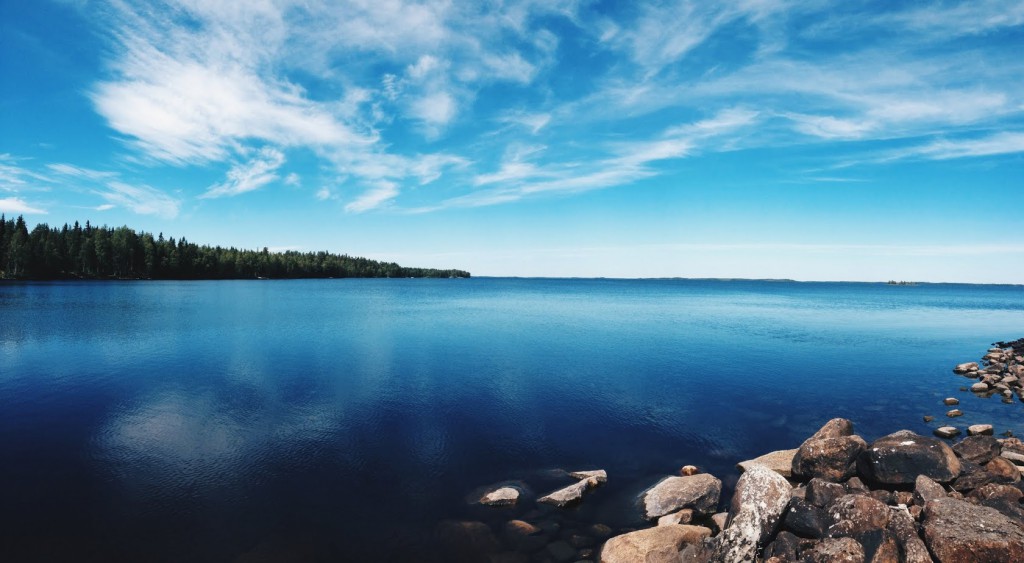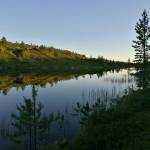There are a lot of things that people relate to Finnishness, the image of introverted people who like their personal space and sauna after a long day of work. I wanted to focus on Finns and our relationship to nature, as well as my own relationship towards it.
Historically Finnish people have always had a strong relationship with nature. Before the spread of Christianity, Finns practiced polytheism, meaning they believed in many different gods, most of them somehow related to nature. There were many gods, creatures and spirits that ancient people believed in. The most important one is probably Ukko, who was the supreme god, in control of the weather, crops and thunder. Tapio was the god of forests from whom hunters asked for good luck in their hunt. Ahti was the god of the sea and people prayed to him for good luck in fishing. (Kalevalanassikat 2014)
There is a deep respect towards nature and the animals that live in the forest. A great example of one of those creatures is Finland’s national animal, the bear, which is featured in the folklore epic called Kalevala. (Weaver 2014) Bears are seen as the most powerful, mythical creatures that live in Finland. A long time ago when a bear was killed, there would be a special celebration called “karhunpeijaiset”. During the celebration there is a deep respect for the killed animal and almost nothing goes to waste, because that would be very disrespectful to the spirit of the bear. Finns have come up with many other names for bears partly for respect, and partly for the fear that the king of the forest will hear its name being spoken and bring bad luck to whoever spoke its name. Even the typical word for bear in Finnish, “karhu”, is not the original word for a bear. (Taivaannaula 2014) Of course, today these traditions have changed but from my own knowledge if an animal is killed not much will go to waste because hunters still respect the animals they kill.
I believe that due to urbanisation and the growth of cities, the relationship between people, especially young people, and nature is weakening. However, interacting with nature is still a huge part of peoples’ past time. From early on children get to develop a bond with nature, some of this comes through physical education in schools where kids are, among other things, taught to ski on an open field and orientate in the forest with a map and a compass. Both of which I was taught in elementary school and I learned skills from both activities that have helped me later on in life as well, whether I was skiing with friends during the winter holidays or trekking in Lapland with a compass in my hand. The photograph below is from one of my trekking trips in Lapland.
Another way that we Finns nourish our relationship to the environment is by exercising our every man’s rights, (in Finnish “jokamiehenoikeudet”) which allows you to enjoy many aspects of the outdoors. This includes the freedom to roam the countryside, go berry picking, foraging, and fishing with a line and rod. Of course, you must be respectful to the environment (no littering, picking protected plants or disturb nesting birds) and stay out from peoples’ yards. Many people go pick their favourite berries, such as bilberries and cowberries among others, as well as foraging for mushrooms this time of year. It is a great past time that many families and friends do every fall, and even if you don’t find the berries or mushrooms you were looking for, it is a great way to hang out, get some exercise and enjoy fresh air. If you wish to learn more about Finland’s every man’s rights, there is a link at the end of this blog post.
Not only is nature great place for doing all sorts of physical exercise, it also increases our mental well-being. Research shows that being in nature lowers blood pressure, decreases stress, and increases happiness. (mielenterveystalo n.d.) For my own part I can say that when I have gone trekking, the everyday worries vanish almost completely, and my mind feels light and my thoughts clear from stress. Whenever I feel stressed about something my immediate reaction is always to go outside, get fresh air and walk or cycle in the forest, perhaps along the shoreline.
Finland’s nature is a source of pride for Finns and based on a study conducted by the Association of Finnish Work, the majority (51% of Finns) feel that nature is the biggest source of pride for us. According to the study almost half of Finns’ ideal mental landscape is a forest, the second most common mental landscape is that of the sea. (Viher-ympäristöliitto 2017) My ideal mental landscape has always been of the sea or a lake, probably because I grew up next to the sea and there is something about living next to it, this great openness and freshness that comes from it that I really appreciate. Another reason for my mental landscape being that of the seashore might be because my family’s summer cottage is right next to the sea. In Finland it is very common that families own their own summer cottage which is a place for relaxation during the holidays and to go swimming and to the sauna, of course.
I believe nature is a core part of Finnish peoples’ identity. It is reflected in the ancient peoples’ beliefs of gods, creatures and spirits that were believed to roam the forests and it is reflected even today when people spend time outdoors, perhaps picking mushrooms with their friends or family. It is reflected in my eyes as I walk through the forest and smile when I hear a bird singing.
More information on every man’s rights:
https://smy.fi/en/teach-learn/forest-education/everymans-rights/
References:
Kalevalanassikat. Suomen muinaiset jumalat. 2014. Published 31.10.2014. Read on 30.9.2019. https://kalevalanassikat.wordpress.com/2014/10/31/suomen-muinaiset-jumalat/
Mielenterveystalo. n.d. Luonnon vaikutus hyvinvointiin. Read on 10.9.2019. https://www.mielenterveystalo.fi/aikuiset/itsehoito-ja-oppaat/oppaat/tietoa_luonnon_hyvinvointivaikutuksista/Pages/luonnon_vaikutus_hyvinvointiin.aspx#sosiaalinen_hyvinvointi
Taivaannaula. 2014. Karhunpaijaiset. Published 31.1.2014. Read on 10.9.2019. http://www.taivaannaula.org/2014/01/31/karhunpeijaiset/
Viher-ympäristöliitto. 2017. Luonto on suomalaisille ylpeyden aihe. Published 30.5.2017. Read on 6.9.2019. https://www.vyl.fi/uutiset/luonto-on-suomalaisille-ylpeyden-aihe/
Weaver, F. 2014. Iconic Finnish Nature Symbols Stand Out. Published August 2014. Read on 13.9.2019. https://finland.fi/life-society/iconic-finnish-nature-symbols-stand-out/


Comments